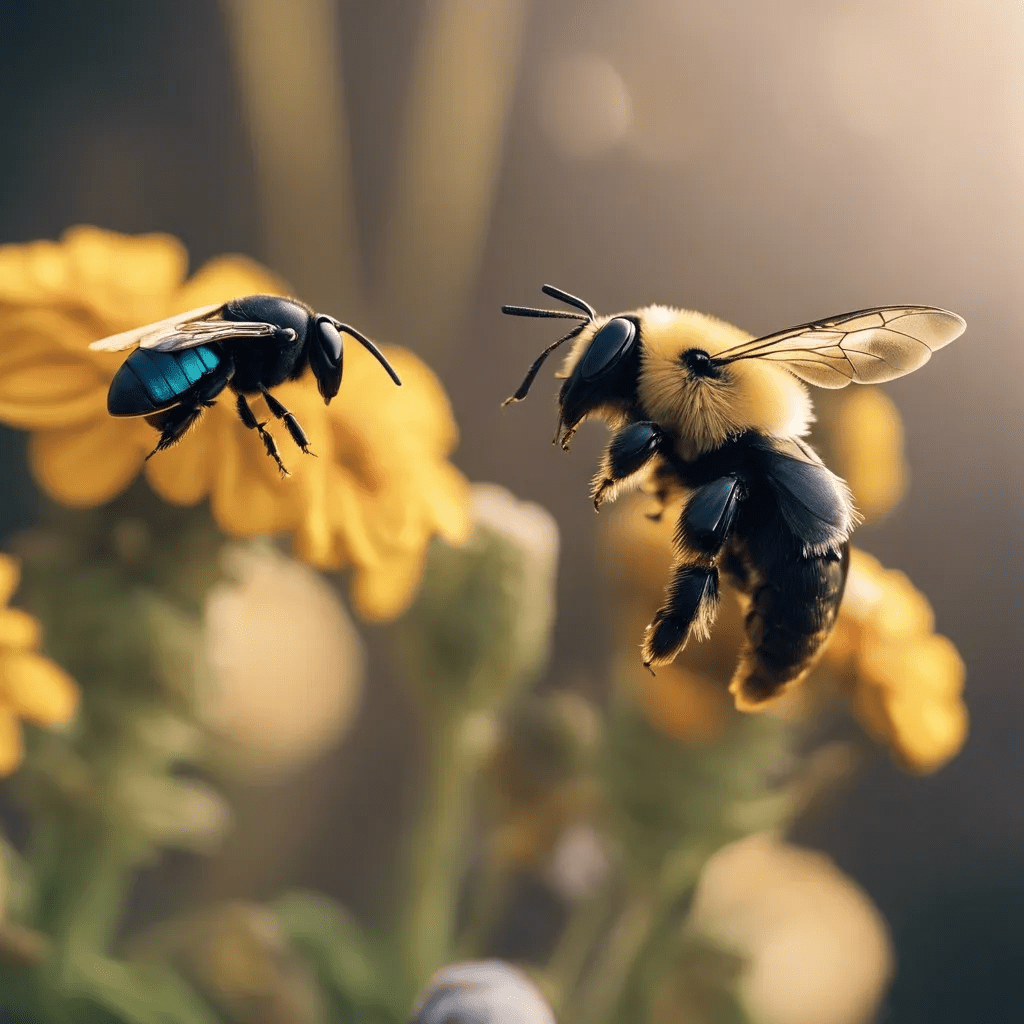Just as a craftsman differs from a social butterfly, so do carpenter bees and bumble bees in the insect kingdom.
You've likely seen both of them buzzing around, but did you know their appearances, behaviors, and roles in our ecosystem vary significantly?
Bumble bees, with their fuzzy bodies, are generally peaceful and live communally in hives. Carpenter bees, on the other hand, sport a sleek black look, tend to be more defensive, and prefer a solitary life, often creating nests in soft, weathered wood.
The story doesn't end here; there's much more to explore about these fascinating creatures.
Physical Characteristics of Carpenter Bees
When it comes to carpenter bees, you'll notice they stand out with their smooth, shiny all-black abdomens, significantly larger than their bumblebee counterparts. These bees boast a length of about 1 inch long, making them quite noticeable. Their shiny abdomen, devoid of the fuzziness you'd typically associate with bees, is a defining characteristic that sets them apart.
In terms of color, it's not all black for carpenter bees. Some species flaunt a white, black, brown, or even blue thorax, adding to their distinct appearance. However, the most striking feature that differentiates male and female carpenter bees is their faces. Males proudly display white faces, while females keep it sleek with black faces.
Identifying Bumble Bees: Key Features
Now that you're familiar with the unique features of carpenter bees, let's turn our attention to their fuzzy counterparts, the bumble bees. These bees are easily identified by their yellow and black hair, providing them with a fuzzy, cuddly appearance. They're smaller in size compared to carpenter bees, but don't let their size fool you.
Bumble bees are social insects that live in communities, quite the opposite of the solitary carpenter bees. They build nests for raising their young, often found in abandoned bird nests, tucked away under wood pieces, or buried in underground tunnels. It's an intricate social structure, with each bee playing its part in the survival of their community.
One key difference to remember is that only female bumble bees have stingers. The males, despite their bravado, are sting-free. But don't worry, these bees are generally non-aggressive unless they feel their nests are threatened. So, as long as you respect their space, they'll respect yours.
In short, bumble bees, with their yellow and black fuzzy bodies and social lifestyles, are a fascinating contrast to the carpenter bees you've learnt about.
Behavioral Differences: Carpenter Vs Bumble Bees
While both carpenter bees and bumble bees play vital roles in our ecosystem, they exhibit strikingly different behaviors, particularly when it comes to their social structures. Understanding the difference between carpenter bees and bumble bees can shed light on their unique behaviors.
Carpenter bees create individual nests. Unlike the social bumble bees, these bees are solitary. A carpenter bee's world mostly revolves around feeding and caring for her offspring. On the other hand, bumble bees are important players in the hive's social structure, working together to feed and protect the colony.
As for aggression, carpenter bees tend to showcase more aggressive behaviors near their nests. However, rest assured that only female carpenter bees can sting. They're usually provoked when their nesting place is threatened. In contrast, bumble bees are generally non-aggressive but will defend their colony and queen if necessary.
In a nutshell, while these bees share similarities in playing crucial roles in pollination, their behaviors highlight their distinct identities. Carpenter bees are the loners that carve homes in wood, while bumble bees are the sociable insects thriving in their communal hives.
Habitat and Nesting Preferences
Moving on from their behavioral differences, let's explore the unique habitat and nesting preferences of carpenter and bumble bees.
Carpenter bees are solitary creatures, preferring to nest alone. They're wood-loving insects, often choosing soft, unpainted, and weathered wood as their home. They create holes in wood for nesting, showcasing their architectural prowess. So, if you've got older or rotting wood around your house, you may be unknowingly providing a perfect habitat for carpenter bees. They're adaptable too, often inhabiting abandoned wood holes created by rodents.
On the other hand, bumble bees are more social insects, living in colonies. Unlike carpenters, they're not exclusive to wood for nesting. They've a versatile approach when it comes to choosing a home. You'd often find them in abandoned bird nests or underground tunnels.
Impact on the Ecosystem and Humans
In the grand tapestry of nature, both carpenter bees and bumble bees weave significant threads, impacting ecosystems and human life in distinct ways. When you compare a carpenter bee vs a bumble bee, you'll notice some differences in their contributions and effects.
Bumble bees, viewed as beneficial insects, are essential pollinators. They play a pivotal role in plant reproduction, enhancing agricultural productivity and promoting biodiversity. Their tireless work helps maintain the health of our ecosystems.
Carpenter bees, on the other hand, have a double-edged impact. They're also pollinators, providing similar benefits to bumble bees. However, their nesting habits can cause structural damage. They bore holes into wood to create nests, which can weaken human-made structures over time. Their nesting can also attract woodpeckers, leading to further damage.
Your perspective might change based on these impacts. While bumble bees are often welcomed for their pollination roles, carpenter bees might be seen as nuisances due to their potential for structural damage. Regardless, it's important to remember that both species play crucial roles in nature's intricate web.
If you're concerned about carpenter bees damaging your home, not sure if you are dealing with a carpenter bee vs bumble bee, or need help with stinging pests, contact My Pest Pros at 703-665-4455 for effective stinging pest protection.
